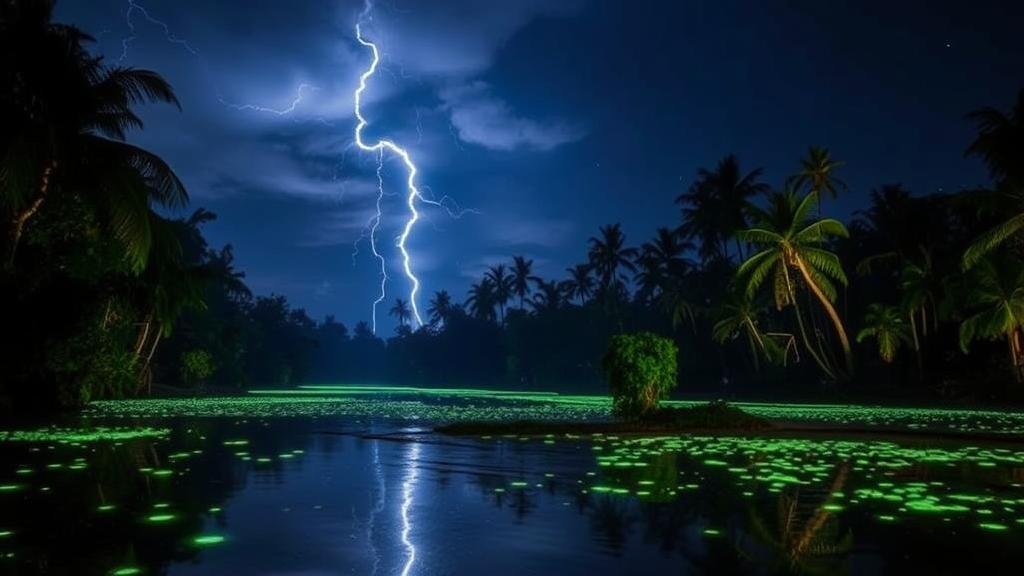Searching for the “River of Disappearing Lights,” an Amazonian tributary where bioluminescent algae vanish on approach.
Searching for the River of Disappearing Lights
Deep within the heart of the Amazon rainforest lies an intriguing phenomenon known as the River of Disappearing Lights, where bioluminescent algae glow brilliantly before vanishing upon approach. This captivating natural spectacle has drawn the attention of scientists, adventure seekers, and environmental enthusiasts alike. To fully appreciate this enigmatic tributary, we will explore its ecological significance, the science behind bioluminescence, and the challenges it faces in todays world.
Location and Historical Context
The River of Disappearing Lights can be found in the vast Amazon basin, particularly within areas of the Brazilian state of Amazonas. Stretching over 1.2 million square kilometers, the Amazon rainforest is home to a diverse range of flora and fauna, making it one of the most biodiverse places on Earth. The region has a rich cultural history, having been inhabited by various indigenous tribes for thousands of years. Many of these communities have legends surrounding the glowing waters, adding an air of mystery to the rivers allure.
Understanding Bioluminescence
Bioluminescence is a natural phenomenon where living organisms produce light through biochemical reactions. In the context of the River of Disappearing Lights, specific species of algae are responsible for this mesmerizing effect. These microscopic organisms contain a pigment called luciferin, which, when oxidized in the presence of the enzyme luciferase, emits light. This adaptation is primarily used as a defense mechanism, making the algae appear to disappear as they react to disturbances.
The Vanishing Act: How It Works
The rivers unique ability to vanish when approached can be likened to a natural smoke-and-mirrors trick. As a boat or person nears the glowing algae, the disturbance from water movement triggers a reaction that causes the glow to fade. This transient display leaves observers in awe and has given the river its captivating name. The phenomenon raises important questions about perception and reality in the natural world, showing how organisms have evolved intricate systems for survival.
Ecological Importance
The River of Disappearing Lights does not merely exist as a tourist attraction; it plays a vital role in the Amazons ecosystem. presence of bioluminescent algae provides several ecological benefits:
- Food Source: Bioluminescent algae form the basis of the food web for many aquatic organisms, serving as a primary food source for fish and other wildlife.
- Indicator of Water Quality: The presence and health of these algae can serve as indicators of water quality, signaling changes in their environment due to pollution or climate change.
- Biodiversity Enhancement: The intricate interactions between bioluminescent algae and their surrounding ecosystems contribute to the overall biodiversity of the region.
Challenges Facing the River
Despite its enchanting beauty, the River of Disappearing Lights faces numerous threats. Environmental concerns such as deforestation, climate change, and pollution pose significant risks to the delicate ecosystems within the Amazon basin. For example:
- Deforestation: Large-scale logging and agricultural practices are leading to habitat loss, which can destabilize the food chain and disrupt life cycles for both the algae and the creatures dependent on them.
- Pollution: Runoff from agricultural chemicals and waste can harm the delicate balance of bioluminescent algae populations.
- Climate Change: Rising temperatures and changing precipitation patterns may affect the natural cycles of bioluminescent organisms, disrupting their growth and reproduction.
Real-World Applications and Conservation Efforts
The fascination with bioluminescence extends beyond mere observation; it has practical applications in various fields. Researchers are exploring ways to harness bioluminescence in medicine, environmental monitoring, and even bioengineering, leading to innovative uses in light sources, imaging, and diagnostics.
Conservation efforts are also underway to protect this unique phenomenon and its habitat. Organizations are working with local communities to promote sustainable practices that can mitigate the impacts of deforestation and pollution. Education initiatives aimed at raising awareness about the ecological importance of the Amazon rainforest are vital for fostering a sense of stewardship among residents and visitors alike.
Actionable Takeaways
If youre intrigued by the River of Disappearing Lights and its mesmerizing bioluminescence, consider the following actions:
- Visit Responsibly: If you plan to explore the Amazon, choose ecotourism options that prioritize sustainability and conservation.
- Support Conservation Efforts: Contribute to organizations focused on preserving the Amazon rainforest and its unique ecosystems.
- Spread Awareness: Share information about the importance of bioluminescence and its ecological roles to inspire others to care for the environment.
To wrap up, the River of Disappearing Lights represents not only a stunning natural wonder but also a crucial component of the Amazonian ecosystem. By understanding its significance and actively working towards its preservation, we contribute to safeguarding one of the planets most extraordinary phenomena for future generations.



